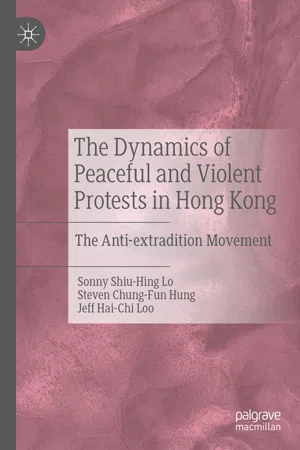Little research has been conducted on the dynamics and interrelationships of peaceful and violent protests. This book aims at designing an analytical framework for us to comprehend the origins, dynamics and interrelationships of peaceful and violent protests. Peaceful protests refer to those demonstrations, rallies, marches and petitions that do not involve any confrontation and conflicts between the participants on the one hand and law-enforcement authorities, notably the police, on the other. Violent protests mean those confrontational encounters and conflict-ridden relations between the protesters and law-enforcement authorities, including the police, paramilitary and military. This chapter will firstly review the literature and conceptual issues shaping the politics of protests, and secondly will come up with a comprehensive framework for us to comprehend the complex relationships between peaceful and violent protests.
The objective of this book is to use the case study of the Hong Kong Special Administrative Region (HKSAR) of the People’s Republic of China (PRC) to explore why an anti-extradition movement, which began from June 2019, continued to last until December 2019. After the outbreak of Covid-19 in China and Hong Kong in early 2020, the protests in the HKSAR have subsided but taken place occasionally. The 2019 movement could be seen as a series of protests against firstly the extradition bill put forward suddenly by the HKSAR government to transfer criminal suspects from Hong Kong to the mainland, and secondly the increasingly assertive police force, which has been playing a crucial role in maintaining law and order since the eruption of the peaceful and violent protests in Hong Kong in June 2019. As a matter of fact, the Hong Kong protests from June to December 2019 could be divided into three overlapping stages: (1) the anti-extradition movement from June to early September when the bill was eventually withdrawn by the HKSAR government; (2) the anti-police protests starting from July 21, 2019, when some triad members went out to attack the passengers of the Mass Transit Railway (MTR) in Yuen Long district; and (3) the anti-authoritarianism and anti-mainlandization protests from June to the present. The ideologies of anti-authoritarianism and anti-mainlandization are intertwined, because the former represents the people’s movement against the transformation of a previously “soft” authoritarian regime of the HKSAR to a much “harder” one characterized by the common phenomenon of the police’s determination to exercise their power more arbitrarily against protesters and to arrest them massively.1 This drift from “soft” authoritarianism to “hard” authoritarianism is ideologically in conformity with the ideology and action of many Hong Kong people, especially protesters, to prevent the HKSAR from becoming more like mainland China politically, economically and socially. Some Hong Kong people, including the protesters, are determined to resist the mainlandization of Hong Kong. The term “mainlandization” is academically referred to a process of making the polity, economy and society of Hong Kong more like the mainland’s monolithic political system, where the ruling Chinese Communist Party (CCP) is powerful and hegemonic, and where its society and economy witness the extensive penetration of the Party-state.2
At the time of writing, the Hong Kong protests continue to be sporadic, taking place occasionally on the streets of Hong Kong especially during weekends. The protests in Hong Kong are complex, as this book will discuss in detail, and it is academically and practically significant for us to understand its origins, dynamics and the interrelationships between peaceful and violent demonstrations. One main argument of this book is that, for us to understand the politics of protests in the HKSAR, the China factor has to be understood. The HKSAR is territorially an indispensable part of China after its return of sovereignty from Britain to the PRC on July 1, 1997. As such, the mainland Chinese policy toward the HKSAR must be considered when we study the politics of peaceful and violent protests.
After all, the triangular issues of the extradition bill, anti-authoritarianism and anti-mainlandization are all directly related to the role of the PRC, as will be discussed later. Once dubbed as “Asia’s finest,” the Hong Kong police force is forefront and prominent in the handling of this tripod of protests against the extradition bill, authoritarian politics and the drift of Hong Kong toward mainlandization. First, it could have played the role of an implementation agent if the extradition bill were passed by the Legislative Council (LegCo). Second, even if it were eventually abandoned, as was the case with Hong Kong in early September when the Chief Executive, Carrie Lam, shelved the bill indefinitely, the police had to maintain law and order by coping with both peaceful and violent protests. Third, the Hong Kong police themselves have to encounter the brunt of public criticisms on whether their actions and performance have already propelled the HKSAR toward a “hard” authoritarian city-state. These actions and performance in 2019 included, for example, the more intensive use of tear gas, the more frequent arrests of political dissidents, the more charges laid upon the protesters who were deemed to violate the law, the increased intensity of conflicts with protesters and the more assertive actions of countering media coverage and reports. Objectively speaking, the police are playing a critical role in maintaining law and order in Hong Kong. At the same time, they are like a political sandwich not only between the HKSAR government and protesters, but also between the PRC regime and local protesters. As such, the Hong Kong police are occupying a pivotal role in the “one country, two systems” principle, which means that the HKSAR can maintain its existing lifestyle and freedom for at least 50 years after July 1, 1997. Whatever actions taken by the local police are bound to be controversial and problematic. The perspective from law enforcement has to be appreciated and understood by the critics of the police. This book is going to adopt an academic, relatively objective, critical and balanced perspective to comprehend the role of Hong Kong police in the dynamic operations of the “one country, two systems” in th...
